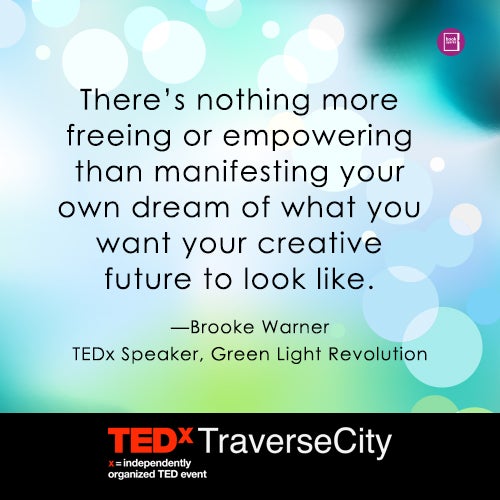Now that my TEDx talk is behind me, I’ll confess to how stressful and all-consuming an experience it is to prep for one of these things. I got notice that my pitch had been accepted in late November. My talk was May 17. For those six months, my mind was hovering on, around, or near my TEDx talk at all times. I stressed about not being far enough along, nearly had a panic attack when I discovered that I would in fact need to memorize the whole thing line for line (not everyone does, but my talk was too tightly stitched to do otherwise), and realized pretty early on that this undertaking—my BHAG, or Big Hairy Audacious Goal—for 2017 was going to be every bit as challenging as previous BHAGs I’d had, like writing a book.
Delivering a great talk is an art, and it’s also something anyone can do. I promise this is true because I’m not a professional speaker. Public speaking is something I’ve been feeling my way into over the past couple years, so the leap to a TEDx stage, for me, was like being pulled from the minor leagues and into the majors. Except that I pulled—or pushed—myself.
Luckily, the resources TED offers you once you’re accepted are tremendous. There are countless videos to study, books to read, and online resources from those who’ve walked before you. I consumed everything, and voraciously. I watched close to fifty talks, read two books, and read many many posts. (I recommend Courtney Martin’s 12 Pieces of Advice for Giving Talks That Have Impact.)

Green-Light Revolution: http://bit.ly/2szv67l
Here’s what I did and learned along the way:
I visualized this goal (for 3 years leading up to my talk) and set it as a strong intention for 2017. I share this because people ask me all the time how I “got it.” I applied, and anyone can and should apply to give a TED or TEDx talk, because it’s not going to just come to you. Get online. Look at the themes (which area always broad). Be willing to travel. Decide that you want it and then get your ear to the ground and figure out when applications are due and start conceptualizing your IDEA WORTH SHARING.
I created video clips long before I ever applied. TED and TEDx want to see video. Sometimes you have to submit a video application (I didn’t), but even if you don’t, having clips under your belt—online on your website, and better yet on YouTube—showcases you onstage. Some of the video content I created well over a year ago, around the launch of my last book, was done with TED in mind, even though I was months from even applying for a talk.
I hired a coach before I landed my talk. I did this early because I had an opportunity to apply to a “closed application” TEDx event. And guess what? My first and second pitches were not accepted. I pressed on, to the point of being a pest, I’m sure. Instead of taking no for an answer, I went back to the drawing board, and then hired a coach to help me rethink my idea. My first two ideas were not big enough, my coach told me, not TED-worthy. My third idea, written with support and encouragement to see bigger than I was seeing, was the one that secured me a spot with TEDx Traverse City.
I wrote the hell out of my talk—for weeks and weeks. I got notice that I’d been accepted in November, read and watched everything I could in December, and started writing in January. I wrote my talk, with the support of that same coach—the fabulous Deborah Siegel of Girl Meets Voice—for ten weeks. This was harder than any chapter or post—and maybe even any book—I’ve written. I went through at least 20 drafts. The goal was to hit just 2500 words (so short for someone who works with books!), to tell stories, to reel the audience in with emotion, to put them in the room, to have “zingers.” My assumption during the writing phase was that I would just loosely memorize my outline and speak extemporaneously, but after ten weeks I realized no friggin’ way—I would have to memorize.
Yes, I memorized my talk. And if I can do it, you can too. The last thing I’d memorized before this was Poe’s The Raven in tenth grade. I do not memorize. It’s not my thing. It makes me nervous. Practice sessions were one long series of crises of confidence. I drove countless miles this spring, which turned out to be a perfect place for memorizing. Even my six-year-old son had my opening paragraph memorized he heard it so many times. I did this always and only out loud, and memorized it in sections. I practiced in front of friends. A fellow TEDx-er told me she spent 100 hours preparing for her talk. This gave me fresh insight as to what I was up against and I hit that number, for sure. You have to metabolize your content—and I did. And even still, my final talk was not without its flaws. But I went out on that stage knowing I knew my talk inside and out. I basically outsmarted my nerves.
Wear something that makes you feel amazing. A TED or TEDx talk turns out to be a great excuse to shop. I bought two outfits before I finally found the dress I ended up wearing. I’m not all that caught up in fashion, and I got tripped up by watching other people’s TED talks. I couldn’t believe how informally some people dressed, which had me second-guessing my choice. But in the end my green dress was both a metaphor for green-lighting (my topic and idea worth sharing) and something that made me feel powerful. I decided it was a good thing to dress in something that made an impact. That’s the whole reason you’re up there in the first place.
Remember to breathe—and do power poses. I power-posed like nobody’s business back in the green room, and it was awesome. I did the victory stance for ten minutes leading up to my talk. It’s better than pacing, and the other TEDx-ers I was with loved it. My little cohort of three women did our power poses and shook off our nerves. It brought me into my body, reminded me to have good posture, and was generally empowering. We really should start every day with power poses.
If your talk lends itself to visuals, add them. I decided to do slides after watching other TED talks. This is not required, at all, just as memorizing isn’t required. But it does make for a more full experience for your audience. It also means you have to hold a clicker, remember yet another thing (change your slides!), and there’s the risk of technical problems (which I had), but I’m still a fan and think my own talk was enhanced by visuals. I created my slide deck, by the way, after I’d completely memorized my script, about a month before my talk.
Take in the space on the day of your talk. I was grateful not to be first onstage, and you can’t control the order your event organizers put you in. But if you happen to be second or later, be in the room ahead of time. I was amazed by the extent to which watching my fellow speakers deflated my own anxiety. I could see myself up on that stage. I felt the warmth of the audience. None of it seemed as big or scary to me as I sat in my chair as an audience member. It gave me the confidence that I could do it.
Flaws are part of the process. I went off-script—slightly—a couple times. The audience didn’t know the difference. I had a slide glitch during rehearsal and it didn’t get properly resolved, which I didn’t discover until my slide just wasn’t there. I’ve been told I recovered well. The best advice someone gave me before my talk was that the audience will receive the talk you give, and if it wasn’t the talk you memorized (exactly), they’ll never know the difference. They’re not sitting out there with your script in hand, and TED audiences want you to succeed.
Thanks for reading, and if you’re thinking about applying for a TED or TEDx talk, do it! The best part of giving a TEDx talk, for me, is having it in the rear-view mirror, but it also gave me an opportunity to embrace things I care about and want for others, like the importance of commitment and dedication, and carving out time for creative pursuits, and stepping into something bigger, and sharing with a bigger audience something that really matters to me. If you’re feeling ready for all that, step up. You got this.
Here’s my talk, Green-Light Revolution: Your Creative Life on Your Terms:
